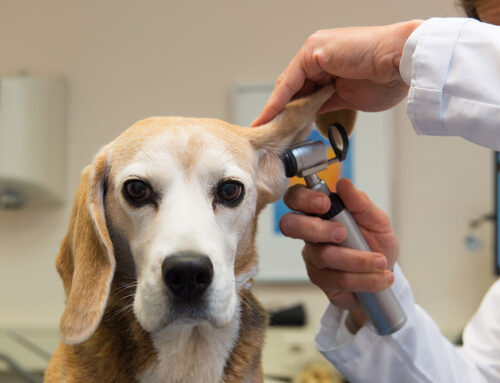If your pet has an ear infection, you’ll likely know by their discomfort. Ear infections can be incredibly painful, and pets who suffer from chronic ear infections are subjected to an endless cycle of irritation, inflammation, and pain. But, if you find the cause of your pet’s chronic ear infections, you can break the cycle and keep them comfortable. Learn how to identify an ear infection in your pet, discover the possible cause, and provide the proper treatment.
Chronic ear infection signs in pets
Pets can develop ear infections in any part of the ear—inner, middle, or outer—but most commonly suffer from outer ear infections, which is the portion you can see. An outer ear infection (i.e., otitis externa) can often be easily identified through an otoscopic examination and ear cytology.
Signs that your pet has an ear infection include:
- Itching
- Reddened, inflamed pinna (i.e., ear flap)
- Pain when touching the ear
- Scabs or crusting in the ear
- Head shaking
- Scratching at the ear
- Excessive debris, wax, or pus in the ear
- Unusual odor from the ear
Chronic ear infection causes in pets
Numerous culprits can lead to chronic ear infections in pets, but the most common reasons include:
- Bacterial and yeast infections — Your pet naturally has some yeast in their ears, but an overgrowth can lead to an infection. Most commonly, yeast infections stem from allergies. Yeast infections can occur with bacterial infections, or affect ears as a solitary infection. Bacterial infections can develop because of excessive moisture or debris in the ear. Yeast and bacterial infections can affect one or both ears, and chronic problems may develop over time.
- Food or environmental allergies — Food and environmental allergies cause skin inflammation, which can trigger ear infections when the sensitive skin inside the ear canal becomes irritated and inflamed. This moist, swollen environment creates the perfect breeding ground for yeast and bacteria inside the ear. Ear infections commonly occur in pets with environmental allergies, and are a key sign of food sensitivities in pets.
- Endocrine disorders — Endocrine disorders, such as diabetes, hypothyroidism, and Cushing’s disease, do more than affect your pet’s metabolism—they can also cause skin changes. The skin can become more fragile and sensitive, and the ears become more susceptible to inflammation and infection. In particular, dogs with hypothyroidism or a low thyroid hormone level are more likely to develop ear and skin infections.
- Masses or polyps in the ear — Masses inside the ear canal can trap excess debris and moisture and cause chronic ear infections. The most common masses are polyps and adenomas, which can lead to bloody or waxy discharge from an ear, along with a foul odor.
- Breed predisposition — Dogs with floppy ears or large amounts of hair in their ears are more prone to ear infections than pets with ears that stand straight up. Breeds such as Labrador retrievers, golden retrievers, poodles, and cocker spaniels tend to be at a higher risk for ear infections. Hound breeds, such as beagles and basset hounds, are also commonly affected because of their long, drooping ears.
- Ear mites — Ear mites commonly cause ear infections in cats, especially if they share a home and are in close contact with infected cats. Dogs are less commonly subjected to ear mite infections, but they can be passed on by their feline housemates. Ear mite infections are exceptionally itchy, and pets often scratch their ears until they bleed. You will also likely notice a dark, crumbly material in their ears that the ear mites feed on.
- Excessive water in the ears — Dogs who spend a lot of time swimming are more likely to develop chronic ear infections, because excessive moisture in the ear canals leads to bacterial growth. Always dry your pet’s ears thoroughly after swimming or a bath to help prevent ear infections.
How can I stop the cycle of my pet’s chronic ear infections?

Since your pet’s chronic ear infections have so many causes, the first step in breaking the cycle is determining the cause. Your Palm City Animal Medical Hospital veterinarian will perform various diagnostic tests, such as an ear cytology, culture and sensitivity, blood work, and possibly allergy testing, to reach a diagnosis.
Once the cause has been determined, treatment can effectively tackle your pet’s ear infection. Many chronic ear infection cases require lifetime management of the underlying cause to minimize flare-ups and reduce your pet’s number of ear infections.
Does your pet routinely suffer from itchy, inflamed, stinky ears? If so, schedule an appointment with our Palm City Animal Medical Center team, so we can diagnose the cause of your pet’s chronic ear infections and provide some relief.








Leave A Comment